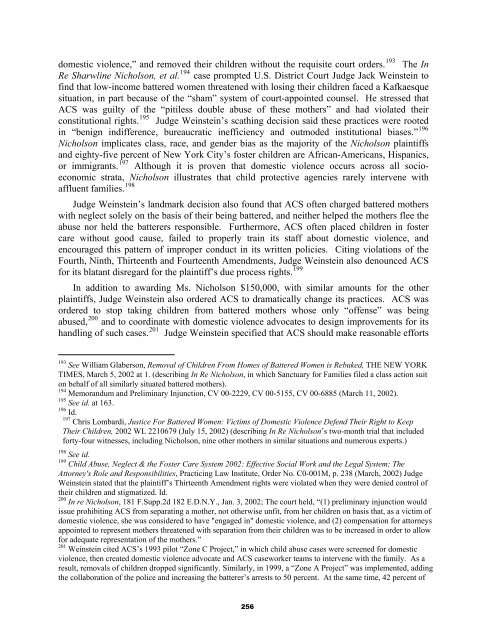A Judge’s Guide
A Judge’s Guide
A Judge’s Guide
Create successful ePaper yourself
Turn your PDF publications into a flip-book with our unique Google optimized e-Paper software.
domestic violence,” and removed their children without the requisite court orders. 193 The In<br />
Re Sharwline Nicholson, et al. 194 case prompted U.S. District Court Judge Jack Weinstein to<br />
find that low-income battered women threatened with losing their children faced a Kafkaesque<br />
situation, in part because of the “sham” system of court-appointed counsel. He stressed that<br />
ACS was guilty of the “pitiless double abuse of these mothers” and had violated their<br />
constitutional rights. 195 Judge Weinstein’s scathing decision said these practices were rooted<br />
in “benign indifference, bureaucratic inefficiency and outmoded institutional biases.” 196<br />
Nicholson implicates class, race, and gender bias as the majority of the Nicholson plaintiffs<br />
and eighty-five percent of New York City’s foster children are African-Americans, Hispanics,<br />
or immigrants. 197 Although it is proven that domestic violence occurs across all socioeconomic<br />
strata, Nicholson illustrates that child protective agencies rarely intervene with<br />
affluent families. 198<br />
Judge Weinstein’s landmark decision also found that ACS often charged battered mothers<br />
with neglect solely on the basis of their being battered, and neither helped the mothers flee the<br />
abuse nor held the batterers responsible. Furthermore, ACS often placed children in foster<br />
care without good cause, failed to properly train its staff about domestic violence, and<br />
encouraged this pattern of improper conduct in its written policies. Citing violations of the<br />
Fourth, Ninth, Thirteenth and Fourteenth Amendments, Judge Weinstein also denounced ACS<br />
for its blatant disregard for the plaintiff’s due process rights. 199<br />
In addition to awarding Ms. Nicholson $150,000, with similar amounts for the other<br />
plaintiffs, Judge Weinstein also ordered ACS to dramatically change its practices. ACS was<br />
ordered to stop taking children from battered mothers whose only “offense” was being<br />
abused, 200 and to coordinate with domestic violence advocates to design improvements for its<br />
handling of such cases. 201 Judge Weinstein specified that ACS should make reasonable efforts<br />
193 See William Glaberson, Removal of Children From Homes of Battered Women is Rebuked, THE NEW YORK<br />
TIMES, March 5, 2002 at 1. (describing In Re Nicholson, in which Sanctuary for Families filed a class action suit<br />
on behalf of all similarly situated battered mothers).<br />
194 Memorandum and Preliminary Injunction, CV 00-2229, CV 00-5155, CV 00-6885 (March 11, 2002).<br />
195 See id. at 163.<br />
196 Id.<br />
197 Chris Lombardi, Justice For Battered Women: Victims of Domestic Violence Defend Their Right to Keep<br />
Their Children, 2002 WL 2210679 (July 15, 2002) (describing In Re Nicholson’s two-month trial that included<br />
forty-four witnesses, including Nicholson, nine other mothers in similar situations and numerous experts.)<br />
198 See id.<br />
199 Child Abuse, Neglect & the Foster Care System 2002: Effective Social Work and the Legal System; The<br />
Attorney's Role and Responsibilities, Practicing Law Institute, Order No. C0-001M, p. 238 (March, 2002) Judge<br />
Weinstein stated that the plaintiff’s Thirteenth Amendment rights were violated when they were denied control of<br />
their children and stigmatized. Id.<br />
200 In re Nicholson, 181 F.Supp.2d 182 E.D.N.Y., Jan. 3, 2002; The court held, “(1) preliminary injunction would<br />
issue prohibiting ACS from separating a mother, not otherwise unfit, from her children on basis that, as a victim of<br />
domestic violence, she was considered to have "engaged in" domestic violence, and (2) compensation for attorneys<br />
appointed to represent mothers threatened with separation from their children was to be increased in order to allow<br />
for adequate representation of the mothers.”<br />
201 Weinstein cited ACS’s 1993 pilot “Zone C Project,” in which child abuse cases were screened for domestic<br />
violence, then created domestic violence advocate and ACS caseworker teams to intervene with the family. As a<br />
result, removals of children dropped significantly. Similarly, in 1999, a “Zone A Project” was implemented, adding<br />
the collaboration of the police and increasing the batterer’s arrests to 50 percent. At the same time, 42 percent of<br />
256


